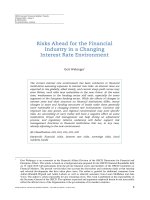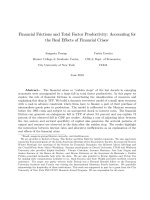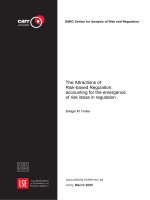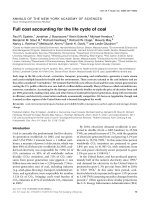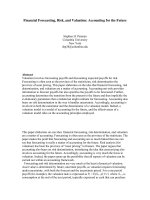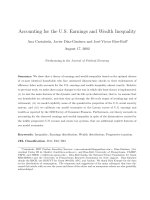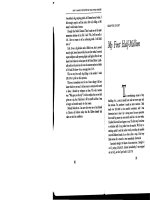Lecture Managerial Accounting for the hospitality industry: Chapter 8 - Dopson, Hayes
Bạn đang xem bản rút gọn của tài liệu. Xem và tải ngay bản đầy đủ của tài liệu tại đây (479.14 KB, 55 trang )
Chapter 8
Revenue Management
for Hotels
© 2009 John Wiley & Sons
Hoboken, NJ 07030
1
Managerial Accounting for the Hospitality Industry
Dopson & Hayes
Chapter Outline
Establishing Room Rates
Revenue Management
Non-Room Revenue
© 2009 John Wiley & Sons
Hoboken, NJ 07030
2
Managerial Accounting for the Hospitality Industry
Dopson & Hayes
Learning Outcomes
Utilize alternative methods when establishing a hotel’s
room rate structure.
Apply revenue management and analysis techniques to
the administration of a hotel’s room rate structure.
Recognize the importance to a hotel of properly
managing and controlling its non-room revenue.
© 2009 John Wiley & Sons
Hoboken, NJ 07030
3
Managerial Accounting for the Hospitality Industry
Dopson & Hayes
Establishing Room Rates
Any serious exploration of hotel room rates and their
management must include basic information about
room rate economics.
Room rate economics recognizes that, when the supply
of hotel rooms is held constant, an increase in demand
for those rooms will result in an increase in their selling
price.
Conversely, when supply is held constant, a decrease
in demand leads to a decreased selling price.
© 2009 John Wiley & Sons
Hoboken, NJ 07030
4
Managerial Accounting for the Hospitality Industry
Dopson & Hayes
Establishing Room Rates
Understanding the law of demand is critical because,
unlike managers in other industries, hoteliers cannot
increase their inventory levels of rooms (supply) in
response to increases in demand.
Hotel managers must also understand that their own
inventory of rooms is highly perishable.
If a hotel does not sell room 101 on Monday night, it will
never again be able to sell that room on that night, and
the potential revenue that would be generated from the
sale is lost forever.
© 2009 John Wiley & Sons
Hoboken, NJ 07030
5
Managerial Accounting for the Hospitality Industry
Dopson & Hayes
Establishing Room Rates
A rack rate is the price at which a hotel sells its rooms
when no discounts of any kind are offered to the guests.
In some cases, it makes sense for hoteliers to create
special event rates. Sometimes referred to as “super”
or “premium” rack, these rates are used when a hotel is
assured of very high demand levels (e.g., Mardi Gras in
New Orleans and New Year’s Eve in New York City).
Hotels often negotiate special rates for selected guests.
In most cases, these negotiated rates will vary by room
type.
In addition to rack and negotiated rates, hotels typically
offer corporate rates, government rates, and group
rates.
© 2009 John Wiley & Sons
Hoboken, NJ 07030
6
Managerial Accounting for the Hospitality Industry
Dopson & Hayes
Establishing Room Rates
Some hotels have great success “packaging” the guest
rooms they sell with other hotel services or local area
attractions.
When a hotel creates a package, the package rate
charged must be sufficient to ensure that all costs
associated with the package have been considered.
In addition, the use of one or more authorized fade
rates, a reduced rate authorized for use when a guest
seeking a reservation is hesitant to make the
reservation because the price is perceived as too high,
can result in even more room rates to be managed.
© 2009 John Wiley & Sons
Hoboken, NJ 07030
7
Managerial Accounting for the Hospitality Industry
Dopson & Hayes
Establishing Room Rates
A hotel’s revenue managers can also create discounts
at various percentage or dollar levels for each rate type
we have examined.
The result is that a hotel, with multiple room types and
multiple rate plans, may have literally hundreds of rates
types programmed into its property management
system.
A property management system (PMS) is a computer
system used to manage guest bookings, online
reservations, check-in/check-out, and guest purchases
of amenities offered by the hotel.
© 2009 John Wiley & Sons
Hoboken, NJ 07030
8
Managerial Accounting for the Hospitality Industry
Dopson & Hayes
The Hubbart Room Rate Formula
The Hubbart formula is used to determine what a hotel’s
average daily rate (ADR) should be to reach the hotel
owner’s financial goals.
The Hubbart formula is a “bottom-up” approach as
shown in Figure 8.2.
To illustrate the Hubbart formula, the Blue Lagoon
Water Park Resort’s Income Statement is shown in
Figure 8.3.
For a detailed analysis of the Hubbart formula, see Go
Figure! following Figure 8.3.
For a summary of the Hubbart formula calculations for
the Blue Lagoon Water Park Resort, see Figure 8.4.
© 2009 John Wiley & Sons
Hoboken, NJ 07030
9
Managerial Accounting for the Hospitality Industry
Dopson & Hayes
Figure 8.2 Comparison of Normal and Bottom-Up Formats
Normal Format for the
Income Statement
Bottom-Up Format for the
Hubbart Formula
Operated Department Income
(Rooms)
Net Income
+ Operated Departments Income
(Excluding Rooms)
+ Taxes
-
Undistributed Operating Expenses
+ Nonoperating Expenses
-
Nonoperating Expenses
+ Undistributed Operating Expenses
-
Taxes
-
=
Net Income
= Operated Department Income
(Rooms)
Operated Departments Income
(Excluding Rooms)
© 2009 John Wiley & Sons
Hoboken, NJ 07030
10
Managerial Accounting for the Hospitality Industry
Dopson & Hayes
Figure 8.3 Income Statement
Blue Lagoon Water Park Resort
Income Statement
For the Period: January 1 through December 31, 2010
Operated Departments
Rooms
Food
Beverage
Telecommunications
Other Operated Departments
Rentals and Other Income
Total Operated Departments
Net
Revenue
Cost of
Sales
?
7,200,000
3,264,000
72,000
540,000
109,800
25,201,800
?
2,138,400
451,440
169,200
79,200
15,840
2,854,080
Undistributed Operating
Expenses
Administrative and General
Information Systems
Human Resources
Security
Franchise Fees
Transportation
Marketing
Property Operations and
Maintenance
Utility Costs
Total Undistributed
Operating Expenses
Gross Operating Profit
25,201,800
2,854,080
Payroll
and
Related
Expenses
Other
Expenses
?
2,188,800
534,960
54,000
180,000
48,960
5,973,120
?
532,800
201,600
28,800
64,800
10,800
2,077,200
?
2,340,000
2,076,000
-180,000
216,000
34,200
14,297,400
921,600
144,000
525,600
199,440
0
50,400
771,840
435,600
244,800
57,600
77,760
0
284,400
780,480
1,357,200
388,800
583,200
277,200
0
334,800
1,552,320
291,600
0
905,400
1,071,000
1,197,000
1,071,000
2,904,480
3,857,040
6,761,520
8,877,600
5,934,240
7,535,880
Income
(Loss)
Rent, Property Taxes, and
Insurance
Depreciation and Amortization
1,760,400
1,260,000
Net Operating Income
4,515,480
Interest
1,272,000
Income Before Income
Taxes
3,243,480
Income Taxes
1,297,390
Net Income
1,946,090
© 2009 John Wiley & Sons
Hoboken, NJ 07030
11
Managerial Accounting for the Hospitality Industry
Dopson & Hayes
g o fig u re!
The steps required to compute the Hubbart formula in this example are:
1. Calculate the hotel’s target before-tax net income. Multiply the required
rate of return (ROI) of the owner’s investment, and then adjust the answer for
before-tax net income.
Assume an investor considers paying $16,217,417 for the 240 room hotel at
the Blue Lagoon and desires a 12% return on the investment.
$16,217,417 x 0.12 = $1,946,090 ROI (hotel’s target net income)
Calculate before-tax net income. Divide the after-tax net income (owner’s
ROI) by 1.00 minus the tax rate.
After-Tax Net Income (ROI)
1.00 – Tax Rate
= Before-Tax Net Income
or, assuming a tax rate of 40%
$1,946,090
1.00 – 0.40 = $3,243,483.30 ~ $3,243,480 (rounded down)
In order to be consistent with the Income Before Taxes number in Figure 8.3,
we will round the before-tax net income down to $3,243,480. Normally, you
wouldn’t round this number down (the IRS would not like that!), but in order
for the Blue Lagoon statements to work nicely for the entire book, the rounded
down number works better.
© 2009 John Wiley & Sons
Hoboken, NJ 07030
12
Managerial Accounting for the Hospitality Industry
Dopson & Hayes
( g o fig u re! continued)
2. Calculate estimated nonoperating expenses. Calculate estimates of
nonoperating expenses including rent, property taxes and insurance plus
depreciation and amortization plus interest expense.
In this example, the total nonoperating expenses are as follows:
Rent, Property Taxes, and Insurance
Depreciation and Amortization
Interest Expense
Total Nonoperating Expenses
1,760,400
1,260,000
1,272,000
$4,292,400
3. Calculate estimated undistributed operating expenses. Calculate
estimates of undistributed operating expenses including administrative and
general, information systems, human resources, security, franchise fees,
transportation, marketing, property operations and maintenance, and utility
costs.
In this example, the total undistributed operating expenses are as follows:
Administrative and General
Information Systems
Human Resources
Security
Franchise Fees
Transportation
Marketing
Property Operations and Maintenance
Utility Costs
Total Undistributed Operating Expenses
© 2009 John Wiley & Sons
Hoboken, NJ 07030
13
1,357,200
388,800
583,200
277,200
0
334,800
1,552,320
1,197,000
1,071,000
$6,761,520
Managerial Accounting for the Hospitality Industry
Dopson & Hayes
( g o fig u re! continued)
4. Calculate estimated operated departments income excluding rooms.
Calculate estimates of revenues minus expenses to determine estimated
income for all non-rooms departments. These include income from food,
beverage, telecommunications, other operated departments, and rentals and
other income.
In this example, estimated operating departments income excluding rooms is
as follows:
Food
Beverage
Telecommunications
Other Operated Departments
Rentals and Other Income
Total Operated Departments Income Excluding Rooms
2,340,000
2,076,000
-180,000
216,000
34,200
$4,486,200
5. Calculate the operated department income for rooms. Using the results
from steps 2 through 4: add the owner's desired ROI (adjusted for before-tax
net income), add total nonoperating expenses, add total undistributed
operating expenses, subtract total operated departments income excluding
rooms (see Figure 8.2).
In this example, estimated operated department income for rooms is as
follows:
Before-Tax Net Income
Total Nonoperating Expenses
Total Undistributed Operating Expenses
Total Operated Departments Income Excluding Rooms
Operated Department Income for Rooms
© 2009 John Wiley & Sons
Hoboken, NJ 07030
14
$3,243,480
+ 4,292,400
+ 6,761,520
- 4,486,200
$9,811,200
Managerial Accounting for the Hospitality Industry
Dopson & Hayes
( g o fig u re! continued)
6. Calculate the estimated rooms department revenues based on
estimated occupancy. Add estimated operated department income for
rooms (from step 5) to estimated rooms expenses based on estimated
occupancy to determine estimated rooms department revenues.
From historical data, the rooms manager has calculated that payroll and
related expenses and other expenses for rooms is $60 per room. Also, the
manager has determined that the hotel has an average occupancy % of 80%,
and the hotel has 240 rooms (see Chapter 1).
Calculate the estimated number of rooms to be sold in the year:
240 rooms x 365 days in a year x 0.80 occupancy = 70,080 rooms
Calculate the estimated rooms expenses based on $60 per room:
70,080 rooms x $60 = $4,204,800
Calculate the estimated rooms department revenues:
Operated Department Income for Rooms
Estimated Rooms Expenses
Estimated Rooms Department Revenues
© 2009 John Wiley & Sons
Hoboken, NJ 07030
15
9,811,200
+ 4,204,800
$14,016,000
Managerial Accounting for the Hospitality Industry
Dopson & Hayes
( g o fig u re! continued)
7. Calculate the hotel’s required ADR. Divide the estimated rooms department
revenues (from step 6) by the estimated number of rooms to be sold (from
step 6):
Estimated Rooms Department Revenues
Estimated Number of Rooms to be Sold
= Hotel’s Required ADR
or
$14,016,000
70,080
= $200
Thus, the ADR that should be charged for the Blue Lagoon’s rooms in order to
achieve the owner’s desired net income (ROI) is $200.
© 2009 John Wiley & Sons
Hoboken, NJ 07030
16
Managerial Accounting for the Hospitality Industry
Dopson & Hayes
Figure 8.4 Summary of Hubbart Formula Calculations for the Blue Lagoon
Steps 1-5:
Bottom-Up Format for the Hubbart Formula
Calculations
Before-Tax Net Income
$ 3,243,480
+
Nonoperating Expenses
+ 4,292,400
+
Undistributed Operating Expenses
+ 6,761,520
-
Operated Departments Income (Excluding Rooms)
- 4,486,200
=
Operated Department Income (Rooms)
$9,811,200
Step 6:
240 rooms x 365 days in a year x 0.80 occupancy = 70,080 rooms
70,080 rooms x $60 expense per room = $4,204,800 estimated rooms
expenses
Operated Department Income for Rooms
Estimated Rooms Expenses
Estimated Rooms Department Revenues
9,811,200
+ 4,204,800
$14,016,000
Step 7:
$14,016,000
70,080
© 2009 John Wiley & Sons
Hoboken, NJ 07030
17
= $200
Managerial Accounting for the Hospitality Industry
Dopson & Hayes
The Hubbart Room Rate Formula
The Hubbart formula is useful because it requires
managerial accountants and hoteliers to consider the
hotel owner's realistic investment goals and the costs of
operating the hotel before determining the room rate.
The formula has been criticized for relying on
assumptions about the reasonableness of an owner’s
desired ROI and the need to know expenses that are
affected by the quality of the hotel’s management.
Another criticism is that the formula requires the room
rate to compensate for operating losses incurred by
other areas (such as from telecommunications).
© 2009 John Wiley & Sons
Hoboken, NJ 07030
18
Managerial Accounting for the Hospitality Industry
Dopson & Hayes
The Hubbart Room Rate Formula
Despite its limitations, the Hubbart formula remains an
important way to view the necessity of developing a
room rate that:
Provides an adequate return to the hotel’s owner(s)
Recovers the hotel’s non-operating expenses
Considers the hotel’s undistributed operating
expenses
Accounts for all the hotel’s non-room operated
departments income (or loss)
Results in a definite and justifiable overall ADR goal
© 2009 John Wiley & Sons
Hoboken, NJ 07030
19
Managerial Accounting for the Hospitality Industry
Dopson & Hayes
The $1.00 per $1,000 Rule
One alternative way that hoteliers have historically
determined room rate is the $1.00 per $1,000 rule.
This rule states that, for every $1,000 invested in a
hotel, the property should charge $1.00 in ADR.
The dollar-per-thousand rule is most accurate for hotels
that have high occupancies, high ADRs for their area of
operation, and are newly built.
© 2009 John Wiley & Sons
Hoboken, NJ 07030
20
Managerial Accounting for the Hospitality Industry
Dopson & Hayes
The $1.00 per $1,000 Rule
Despite some limitations, the $1.00 per $1,000 rule
does reflect the tendency for hotel buyers to discuss
hotel selling prices in terms of a hotel’s cost per key
(average cost per room), which is the average purchase
price of a hotel’s guestroom expressed in thousands of
dollars.
It is important to recognize that the rate computed using
the $1.00 per $1,000 rule does not become the hotel’s
rack rate.
Instead, it is the overall ADR that the hotel must achieve
when its sells all of its various rooms at all of their
respective rates.
© 2009 John Wiley & Sons
Hoboken, NJ 07030
21
Managerial Accounting for the Hospitality Industry
Dopson & Hayes
Alternative Room Rate
Methodologies
Non-traditional, non-cost methods to establish rates:
Competitive Pricing. Charge what the competition
charges.
Follow the Leader Pricing. Charge what the
dominant hotel in the area charges.
Prestige Pricing. Charge the highest rate in the area
and justify it with better product and/or service levels.
Discount Pricing. Reduce rates below that of the
likely competitors.
© 2009 John Wiley & Sons
Hoboken, NJ 07030
22
Managerial Accounting for the Hospitality Industry
Dopson & Hayes
Web-Influenced Room Rate
Methodologies
Today’s hotel room rate structures have been changed,
and changed forever, by the advent of the Internet as
the most popular method used for selling hotel rooms.
As a result of the Internet, consumers can easily
compare prices, but so can a hotel’s major competitors.
While the call-around was standard practice as late as
the early 2000s, consider modern hoteliers utilizing one
of the many websites similar to
and others that allow him/her
to easily see other hotels’ rates.
© 2009 John Wiley & Sons
Hoboken, NJ 07030
23
Managerial Accounting for the Hospitality Industry
Dopson & Hayes
Web-Influenced Room Rate
Methodologies
Guests care very little how much it “costs” a hotel to
provide its rooms.
They care about the lodging value they receive.
As a result, a hotel’s rates are heavily influenced by the
laws of supply and demand.
A guest can make a hotel reservation at a given rate,
and, every day until the date of arrival, can go online to
shop for an even lower price for the same room.
If a lower rate were to be found, the guest could recontact the hotel, cancel the original reservation, and
secure the new, lower rate.
© 2009 John Wiley & Sons
Hoboken, NJ 07030
24
Managerial Accounting for the Hospitality Industry
Dopson & Hayes
Revenue Management
Revenue management, also called yield management,
is a set of techniques and procedures that use hotel
specific data to manipulate occupancy, ADR, or both for
the purpose of maximizing the revenue yield achieved
by a hotel.
Yield is a term used to describe the percentage of total
potential revenue that is actually realized.
Revenue managers are responsible for making
decisions regarding the pricing and selling of guest
rooms in order to maximize yield.
© 2009 John Wiley & Sons
Hoboken, NJ 07030
25
Managerial Accounting for the Hospitality Industry
Dopson & Hayes

